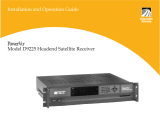Contents
2
Contents
Introduction....................................................................................................................................................... 3
System requirements ....................................................................................................................................... 3
Computer minimum requirements ............................................................................................................. 3
Static IP address ....................................................................................................................................... 3
Physical connection to headend ............................................................................................................... 3
Service tool ....................................................................................................................................................... 4
Overview ....................................................................................................................................................... 5
Icons.......................................................................................................................................................... 5
Tabs .......................................................................................................................................................... 6
Misc. Buttons ............................................................................................................................................. 6
Configuring CA modules .................................................................................................................................. 7
Pre-requisites ............................................................................................................................................ 7
Configuration ............................................................................................................................................. 7
Resetting ................................................................................................................................................. 10
Modifying ................................................................................................................................................. 11
Deleting ................................................................................................................................................... 12
Configuring PAL output modules .................................................................................................................... 13
Pre-requisites .......................................................................................................................................... 13
Configuration ........................................................................................................................................... 13
Modifying ................................................................................................................................................. 17
Deleting ................................................................................................................................................... 17



















